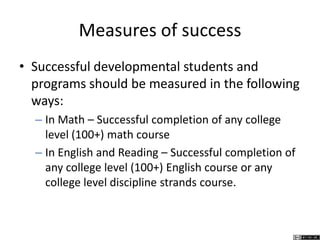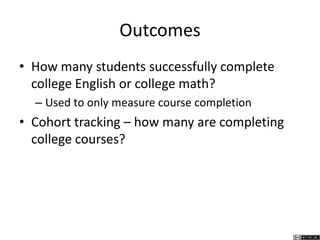Student services regional introduction to redesign
- 1. The problem “The more levels of developmental courses a student needs to go through, the less likely that student is to ever complete college English or math.” - Thomas Bailey (2009) CCRC Brief.
- 2. Traditional Colorado course pipeline MAT 030 MAT 060 MAT 090 MAT 099 ENG 030 ENG 060 ENG 090 REA 030 REA 060 REA 090
- 3. Why high attrition rates are a structural problem • For students who place two levels below a college course there are 5 “exit points” – Do they pass the first course – Do they enroll in the next course? – Do they pass the second course? – Do they enroll in the college-level course? – Do they pass the college-level course? • Students placing three levels down have 7 exit points.
- 4. Why high attrition rates are a structural problem • CCCS example for students who completed ENG 030 - fall 2010 – Completed 030(538) 100% – Do they enroll and complete 060 (189) 35% – Do they enroll in and complete 090 (32) 6%
- 5. The goal of the redesign Move students quickly and effectively through their first college level course.
- 6. Board adopted policy in February 2013 To accelerate students by reducing the amount of time, number of developmental credits, and number of courses in the developmental sequence so students can have access to and be supported for success in a college level course.
- 7. What “Redesign” looks like • Math – pathways at the developmental level – Algebra – Non-Algebra (statistics and math for liberal arts) – Non-transfer (career math, clinical calculations) • College Composition and Reading (formerly reading and English) – Integrated disciplines – Tiers of student support in classrooms
- 8. Testing • Working with Pearson on a diagnostic • Tentative timeline – we still don’t have a product or contract – Item analysis Fall 13 – Test analysis Spring 14 – Test pilot Fall 14 – Test implementation Spring 15
- 9. Student support • Use CCCSE practices – Orientation – Goal setting and planning – No late registrations – First year experience – Student success course – Tutoring – Supplemental instruction – Case management/academic advising/career coaches
- 10. Student Services Plans • College develop a plan to use for planning, initiating, and sustaining success for developmental students
- 11. Measures of success • Successful developmental students and programs should be measured in the following ways: – In Math – Successful completion of any college level (100+) math course – In English and Reading – Successful completion of any college level (100+) English course or any college level discipline strands course.
- 12. Outcomes • How many students successfully complete college English or college math? – Used to only measure course completion • Cohort tracking – how many are completing college courses?
- 13. Implementation teams • Core implementation team – Faculty – Focused on curriculum, content, training, and professional development • Redesign advisory group – Administrative (Banner, fiscal, advising, financial aid) – Testing – faculty for content. Testing center directors when we have a platform to experiment with. •
- 14. Timeline • Spring/summer 13 discipline team work to develop curriculum and to create professional development training for faculty and staff • Fall of 13 schools that are already working on redesign will ramp up projects • Spring 14 all colleges should transition to the new models • Fall of 14 all colleges should be operating with the new models in place
- 15. Example of Student Services Plan from Lamar Community College
- 16. Student Services • CCSSE strategies for planning, initiating, and sustaining success. All developmental education students will: – Required to seek academic advising prior to the start of each semester – Required to meet with the career advisor at least once each semester – Students who are in both math and CCR courses will be required to enroll in an academic success course – Strongly encouraged to enroll in an academic success course
- 17. Big areas for immediate campus decisions • CCR • Math • Student services • Timing
- 18. Places to go for more information • DE site • Word Press site • D2L shells • Campus teams • Regional training • Invited presentations • 2:2 sharing
- 19. CREATIVE COMMONS ATTRIBUTION This work by Colorado Community College System COETC Grant is licensed under a Creative Commons Attribution 3.0 Unported License. The material was created with funds from the Trade Adjustment Assistance Community College and Career Training (TAACCCT) Grant awarded to the Colorado Online Energy Training Consortium (COETC).Based on a work at www.cccs.edu.Permissions beyond the scope of this license may be available at www.cccs.edu.


















